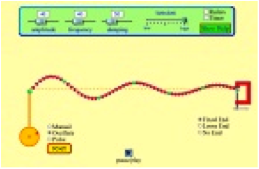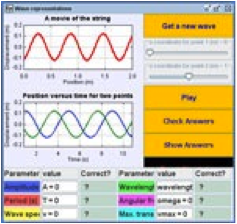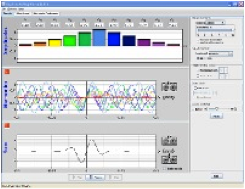Topic 1 - Complete Toolkit
Objectives
-
Describe the nature of a wave as a disturbance that moves through a medium, transporting energy without transporting matter.
-
Distinguish local particle vibrations from overall wave motion and relate these distinctions to types of waves such as longitudinal, transverse and surface waves.
-
Demonstrate understanding of wave properties such as wavelength, amplitude, frequency, period, and speed and mathematically relate these properties to one another.
-
Apply the relationship among wave speed, frequency, and wavelength to solve problems.
-
Build understanding of the relationship between energy and amplitude.
Readings from The Physics Classroom Tutorial
-
The Physics Classroom Tutorial, Waves Chapter, Lesson 1
http://www.physicsclassroom.com/class/waves/Lesson-1/Waves-and-Wavelike-Motion
-
The Physics Classroom Tutorial, Waves Chapter, Lesson 2
http://www.physicsclassroom.com/class/waves/Lesson-2/The-Anatomy-of-a-Wave
Interactive Simulations
-
 PhET Simulation: Wave on a String
PhET Simulation: Wave on a String
Wiggle the string to create a wave. Set frequency, amplitude, and tension and watch the results…..or manually generate the disturbance. You can choose fixed, loose, or no end.
-
 Wave Representations Model
Wave Representations Model
A flexible model that displays motion of a wave on a string alongside Displacement/Time graph for two points on the string. Using only these representations, you can determine amplitude, period, wavelength, and wave speed. Run as a simulation or customize for your class. Worksheet included.
-
 PhET Simulation: Fourier-Making Waves
PhET Simulation: Fourier-Making Waves
More advanced simulation lets learners create different kinds of waves by adding sines or cosines. Developed to promote understanding of Fourier functions and help students become comfortable with mathematical expressions for waves. (Great resource for gifted/talented.)
Video and Animations
Labs and Investigations
-
The Physics Classroom, The Laboratory, A Wiggle in Time
Students observe and describe the motion of a mass on the end of a spring. Using a motion detector, they describe the motion with words, with graphs, and in mathematical terms.
-
The Physics Classroom, The Laboratory, A Wiggle in Time and Space
Students explore the connection between a mass vibrating on a spring and a collection of particles vibrating back and forth about a fixed position along the medium as a wave passes through the medium.
-
The Physics Classroom, The Laboratory, Wave Motion
Students observe simulations and observe the difference between longitudinal, transverse and surface waves.
-
The Physics Classroom, The Laboratory, Speed of a Wave
Students investigate the variables that do and do not affect the speed of a wave.
Demonstration Ideas
-
Waves With Trolleys
Highly visual demo uses dynamics trolleys, springs, and spring holders to model transverse and longitudinal waves. Easy set-up, yet allows exploration of complex concepts such as how a dispersive system differs from a continuous wave medium like a rope or slinky. Developed by Practical Physics.
-
Wave Motion Machine
An oldie but goodie….this 28-minute historic film features physicist John Shive demonstrating his torsional “wave machine” at Bell labs. Watch wave reflection from fixed and free ends, wave superposition, standing waves, and wave impedance. If time is limited, start the video at 6 minutes and watch to 11 minutes. Students can see the real-life wave motion and compare it to the simulations.
Minds on Physics Internet Modules
The Minds On Physics Internet Modules are a collection of interactive questioning modules that target a student’s conceptual understanding. Each question is accompanied by detailed help that addresses the various components of the question.
-
Waves module, Assignment WM1 – Nature and Categories of Waves
-
Waves module, Assignment WM2 – Wave Characteristics
-
Waves module, Assignment WM3 – Speed of a Wave
Source:
http://www.physicsclassroom.com/mop
Conceptual Building Exercises:
-
The Physics Classroom, Curriculum Corner, Wave Basics, Waves
-
The Physics Classroom, Curriculum Corner, Wave Basics, Describing Waves
-
The Physics Classroom, Curriculum Corner, Wave Basics, Wave Speed
Source:
http://www.physicsclassroom.com/curriculum/waves
Problem-Solving Exercises:
-
The Physics Classroom, The Calculator Pad, Wave Basics, Problems #1-17
Source:
http://www.physicsclassroom.com/calcpad/waves
Science Reasoning Activities:
-
The Physics Classroom, Science Reasoning Center, Waves: Mass on a Spring
Source:
http://www.physicsclassroom.com/reasoning/waves
Common Misconceptions
-
What Moves?
It is common for students to believe that waves involve the transport of matter from the source to a distant location. Emphasize that waves do not transport matter. What one sees as a wave moves through a SlinkyTM or water is the movement of a pattern of crests and troughs (or compressions and rarefactions); this results in the movement of energy without any movement of matter. Particles within the medium (i.e., matter) simple vibrate back-and-forth about a fixed position.
-
Confusion of Frequency and Speed
Students often confuse the concepts of wave frequency and wave speed. Wave speed refers to how fast a wave moves and is related to the distance traveled by a point on a wave per unit of time. Speed is much different than frequency. Frequency describes how often particles of the medium undergo vibrations about their fixed position. A medium in which particles vibrate frequently about a fixed position is not necessarily a fast wave. Be cautious of your own use of the terms frequency and speed and monitor the language of students and gently correct those who describe frequent vibrations as fast.
Elsewhere on the Web:
Student Difficulties with Wave Concepts
A must-read presentation by Michael Wittmann, physics professor and team member of the University of Maryland PER (Physics Education Research Group). The resource is freely accessible as a set of 44 slides, exported from Power Point to html to support ease of user download. See the results of research on how students formulate mental models of waves concepts and learn to recognize common misconceptions.
Standards
A. Next Generation Science Standards (NGSS)
Disciplinary Core Ideas
-
High School-PS4.A.i The wavelength and frequency of a wave are related to one another by the speed of travel of the wave, which depends on the type of wave and the medium through which it is passing.
-
High School-PS4.A.iii Waves can add or cancel one another as they cross, depending on their relative phase (i.e., relative position of peaks and troughs of the waves), but they emerge unaffected by each other.
-
Middle School-PS4.A.i A simple wave has a repeating pattern with a specific wavelength, frequency, and amplitude.
Performance Expectations
-
Middle School PS4-1 Use mathematical representations to describe a simple model for waves that includes how the amplitude of a wave is related to the energy in a wave.
-
Middle School PS4-2 Develop and use a model to describe that waves are reflected, absorbed, or transmitted through various materials.
-
High School PS4-1 Use mathematical representations to support a claim regarding relationships among the frequency, wavelength, and speed of waves traveling in various media.
Science and Engineering Practices (SEPs)
Practice #1: Developing and Using Models
-
Develop and/or use multiple types of models to provide mechanistic accounts and/or predict phenomena, and move flexibly between model types based on merits and limitations.
-
Develop and/or use a model (including mathematical and computational) to generate data to support explanations, predict phenomena, analyze systems, and/or solve problems.
Practice #3: Planning and Carrying Out Investigations
-
Plan and conduct an investigation individually and collaboratively to produce data to serve as the basis for evidence, and in the design: decide on types, how much, and accuracy of data needed to produce reliable measurements and consider limitations on the precision of the data (e.g., number of trials, cost, risk, time), and refine the design accordingly.
Practice #4: Analyzing Data
-
Compare and contrast various types of data sets (e.g., self-generated, archival) to examine consistency of measurements and observations.
Practice #5: Using Mathematics and Computational Thinking
-
Create and/or revise a computational model or simulation of a phenomenon, designed device, process, or system.
-
Apply techniques of algebra and functions to represent and solve scientific and engineering problems.
Practice #6: Constructing Explanations
-
Construct and revise an explanation based on valid and reliable evidence obtained from a variety of sources (including students’ own investigations, models, theories, simulations, peer review) and the assumption that theories and laws that describe the natural world operate today as they did in the past and will continue to do so in the future.
Practice #8: Obtaining, Evaluating, and Communicating Information
-
Critically read scientific literature adapted for classroom use to determine the central ideas or conclusions and/or to obtain scientific and/or technical information to summarize complex evidence, concepts, processes, or information presented in a text by paraphrasing them in simpler but still accurate terms.
-
Compare, integrate and evaluate sources of information presented in different media or formats (e.g., visually, quantitatively) as well as in words in order to address a scientific question or solve a problem.
B. Common Core Standards (CC) – Grades 9-12 Mathematics
Standards for Mathematical Practice
-
Reason abstractly and quantitatively
-
Model with mathematics
High School – Number and Quantity: Quantities
-
N-Q.1 Use units as a way to understand problems and to guide the solution of multi-step problems; choose and interpret units consistently in formulas.
High School – Algebra: Interpret the Structure of Expressions
-
A-SSE.2 Use the structure of an expression to identify ways to rewrite it.
High School – Algebra: Represent and Solve Equations and Inequalities Graphically
-
A-REI.10 Understand that the graph of an equation in two variables is the set of all its solutions plotted in the coordinate plane, often forming a curve.
High School – Functions: Interpret Functions that Arise in Applications in Terms of the Context
-
F-IF.5 Relate the domain of a function to its graph and, where applicable, to the quantitative relationship it describes.
-
F-IF.6 Calculate and interpret the average rate of change of a function (presented symbolically or as a table) over a specified interval. Estimate the rate of change from a graph.
High School – Functions: Compare Properties of Two Functions
-
F-IF.9Compare properties of two functions each represented in a different way (algebraically, graphically, numerically in tables, or by verbal descriptions).
High School – Trigonometric Functions: Model Periodic Phenomena
-
F-TF.5 Choose trigonometric functions to model periodic phenomena with specified amplitude, frequency, and midline.
-
F-TF.7 Use inverse functions to solve trigonometric equations that arise in modeling contexts, evaluate the solutions using technology, and interpret them in terms of a context.
C. Common Core Standards (CC) – Grades 9-12 English/Language Arts
High School – Reading Standards for Literacy in Science and Technical Subjects
-
RST.11-12.2 Determine the central ideas of conclusions of a text; summarize complex concepts, processes, or information presented in a text by paraphrasing them in simpler but still accurate terms.
-
RST.11-12.4 Determine the meaning of symbols, key terms, and other domain-specific words and phrases as they are used in a specific scientific or technical context relevant to grades 11-12 texts and topics.
-
RST.11.12.7 Integrate and evaluate multiple sources of information presented in diverse formats and media (e.g., quantitative data, video, multimedia) in order to address a question or problem.
-
RST.11-12.9 Synthesize information from a range of sources (e.g., texts, experiments, simulations) into a coherent understanding of a process, phenomenon, or concept, resolving conflicting information when possible.
-
RST.9-12.10 By the end of Grade 10, read and comprehend science/technical texts in the grades 11-CCR text complexity band independently and proficiently.
D. College Ready Physics Standards (Heller and Stewart)
Objective 4.3 Mechanical Wave Interactions and Energy
Middle School: A mechanical wave interaction occurs when a vibrating object (energy source) produces a wave disturbance that travels through a material (medium). This wave disturbance transfers energy to an object at a distance (energy receiver) by displacing the material, but not transferring it. Although the material is temporarily displaced, it returns to its original (undisturbed) position. (M.4.3.1)
-
A wave disturbance travels approximately at a constant speed through a uniform material (medium). The speed of the wave depends on the nature of the material (e.g., the wave travels faster through a solid than through a gas). As the frequency (f) of a wave through a material increases, the wavelength of the wave decreases.
-
For a given material (medium), the amount of energy transfer during mechanical wave interaction during a defined time interval depends on the frequency and amplitude of the vibrating energy source.
-
There are two primary types of waves: transverse waves (e.g. ropes) and compression (longitudinal) waves (e.g., slinky, sound waves). Some waves, such as seismic waves, have both components.
-
A mechanical wave requires a material (solid, liquid, or gas) in which to travel and is characterized by three variables: frequency, wavelength, and amplitude.